- Clone
- R3-5G4 (See other available formats)
- Regulatory Status
- RUO
- Other Names
- Runt related transcription factor 3, Acute myeloid leukemia 2, Core binding factor α 3 subunit, Polyomavirus enhancer-binding protein 2 α C subunit,
- Isotype
- Mouse IgG1
- Ave. Rating
- Submit a Review
- Product Citations
- publications
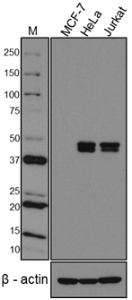
-

Total cell lysates (15 µg protein) from MCF-7 (negative control), HeLa, and Jurkat cells were resolved by 4-20% Tris-Glycine gel electrophoresis, transferred to nitrocellulose, and probed with 1.0 µg/mL (1:500 dilution) of purified anti-Runx3 antibody, clone R3-5G4. Proteins were visualized by chemiluminescence detection using a goat anti-mouse-IgG secondary antibody conjugated to HRP (Cat. No. 405301) at a 1:3000 dilution. Direct-Blot™ HRP anti-β-actin Antibody (Cat. No. 643807) was used as a loading control (lower) at a 1:2000 dilution. Lane M: MW ladder. -

Whole cell extracts (180 µg total protein) prepared from Raji cells were immunoprecipitated overnight with 2.5 µg of purified mouse IgG1, κ isotype ctrl antibody (clone MG1-45) (Cat. No. 401402) or purified anti-RUNX3 antibody (clone R3-5G4). The resulting IP fractions and whole cell extract input (5%) were resolved by 4-12% Bis-Tris gel electrophoresis, transferred to a PVDF membrane and probed with a rabbit antibody against human RUNX3 overnight at 4°C. Proteins were visualized by chemiluminescence detection using HRP donkey anti-rabbit IgG (minimal x-reactivity) antibody (Cat. No. 406401) at a 1:3000 dilution. Lane M: Molecular weight marker.
| Cat # | Size | Price | Quantity Check Availability | Save | ||
|---|---|---|---|---|---|---|
| 697901 | 25 µg | 81€ | ||||
| 697902 | 100 µg | 205€ | ||||
The runt related transcription factor (Runx3) is a downstream effector of the TGF-β signaling axis, and has been shown to play a critical function in cancer metastasis through transcriptional control of genes involved in apoptosis, cell signaling, cell migration, and invasion. Additionally, Runx3 plays an essential role in differentiation of CD8 and NK cells. Runx3 forms a heterodimer with the CBFβ subunit. The Runx3-CBFβ complex binds to the core sequence 5'-PYGPYGGT-3' found in enhancer and promoter regions of its target genes, where it can either induce or suppress gene expression. Evidence suggests Runx3 functions as a tumor suppressor in many cancers.
Product DetailsProduct Details
- Verified Reactivity
- Human
- Antibody Type
- Monoclonal
- Host Species
- Mouse
- Immunogen
- Purified recombinant fragment of human Runx3 (aa: 187-234).
- Formulation
- Phosphate-buffered solution, pH 7.2, containing 0.09% sodium azide.
- Preparation
- The antibody was purified by affinity chromatography.
- Concentration
- 0.5 mg/ml
- Storage & Handling
- The antibody solution should be stored undiluted between 2°C and 8°C.
- Application
-
WB - Quality tested
IP - Verified - Recommended Usage
-
Each lot of this antibody is quality control tested by Western blotting. For Western blotting, the suggested use of this reagent is 0.125 - 1.0 µg per mL (1:4000-1:500 dilution). For immunoprecipitation, the suggested use of this reagent is 2.5 µg/test. It is recommended that the reagent be titrated for optimal performance for each application.
- Application Notes
-
This antibody recognizes the two isoforms of Runx3 with predicted molecular weights of 44.4 and 45.9 kD.
This clone is not recommended for ChIP (Chromatin Immunoprecipitation) assays (as determined by in-house testing). - Application References
-
- Kim JH, et al. 2014. Oncogenesis. 3: e101. (WB, IP)
- Fu Y, et al. 2011. J. Biol. Chem. 13:11803. (WB, IP)
- Ito K, et al. 2008. Cancer Cell. 14: 226. (WB, IP)
- Yano T, et al. 2006. Mol. Cell Biol. 26: 4474. (WB, EMSA)
- Ito K, et al. 2005. Cancer Research. 65: 7743. (WB)
- Product Citations
-
- RRID
-
AB_2687206 (BioLegend Cat. No. 697901)
AB_2687206 (BioLegend Cat. No. 697902)
Antigen Details
- Structure
- 415 and 429 amino acid isoforms with a predicted molecular weight of 44.4 and 45.9 kD, respectively. Isoform 2 has an alternate 19 amino acid in place for the N-terminal 5 amino acids of isoform1. Contains an N-terminal Runt domain, a 120 amino acid region that confers DNA-binding and heterodimerization function, and a proline/serine/threonine rich C-terminal transactivation domain.
- Distribution
-
Cytoplasm, nucleus.
- Function
- Runx3 facilitates transcriptional regulation of its target genes; functions as tumor suppressor in many types of cancer. Phosphorylation of Runx3 abrogates DNA-binding activity and affects its subcellular localization.
- Interaction
- Forms a heterodimer with subunit CBFβ. DNA-binding affinity is increased by heterodimerization with CBFβ. Interacts with R-SMADs, TLE1, SRC, FYN, LCK, FOXP3, and ZFHX3.
- Antigen References
-
1. Park J, et al. 2017. Oncotarget. 8:9079.
2. Llorca-Cardenosa MJ, et al. 2016. Oncotarget. 7: 63424.
3. Chuang LS, et al. 2016. Proc. Natl. Acad. Sci. U S A. 113:6490.
4. Ebihara T, et al. 2015. Nat. Immunology. 16:1124.
5. Whittle MC, et al. 2015. Cell. 161:1345. - Gene ID
- 864 View all products for this Gene ID
- UniProt
- View information about Runx3 on UniProt.org
Related Pages & Pathways
Pages
Related FAQs
Other Formats
View All Runx3 Reagents Request Custom Conjugation| Description | Clone | Applications |
|---|---|---|
| Purified anti-Runx3 | R3-5G4 | WB,IP |
Customers Also Purchased
Compare Data Across All Formats
This data display is provided for general comparisons between formats.
Your actual data may vary due to variations in samples, target cells, instruments and their settings, staining conditions, and other factors.
If you need assistance with selecting the best format contact our expert technical support team.
 Login / Register
Login / Register 




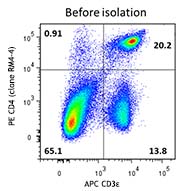
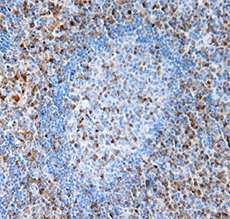
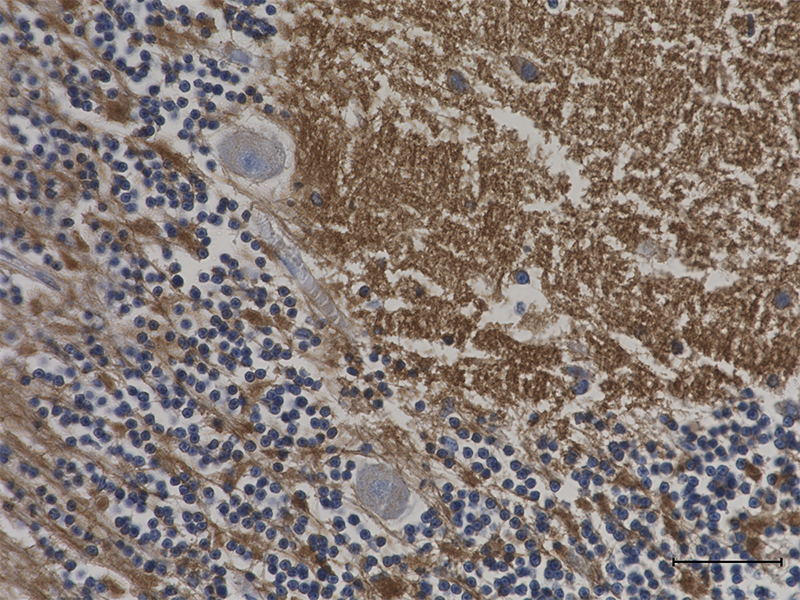

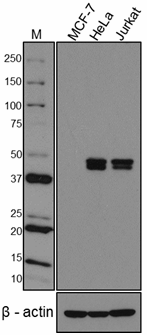
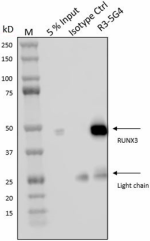



Follow Us